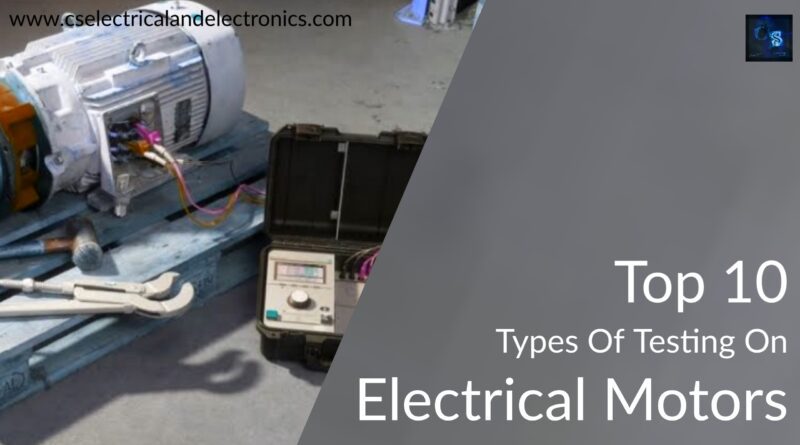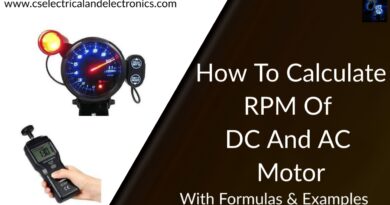Top 10 Types Of Testing On Electrical Motors, Electrical Motor Testing
Hello guys, welcome back to my blog. In this article, I will discuss the top 10 types of testing on electrical motors, electrical motor testing, why it is conducted, and types of tools used for electrical motor testing.
If you have any doubts related to electrical, electronics, and computer science, then ask questions. You can also catch me on Instagram – Chetan Shidling.
Also, read:
- Circuit Breaker Testing, Top 10 Types Of Testing On Circuit Breakers
- Difference Between Hydrogen And Lithium, Future Of Electric Vehicle
- Top Types Of Testing On Power Transformers Done Before Use
Types Of Testing On Electrical Motors
While the motor is functioning, online dynamic testing is performed. It provides technicians with information on the motor’s power quality and operational condition. All data necessary for electric motors should be collected and trended using dynamic testing equipment. Power condition, voltage level, voltage imbalance and harmonic distortions, current levels and imbalances, load levels, torque and rotor bar signatures, and so on are all included. Through indications such as power condition, motor condition and performance, load assessment, and operational efficiency, the obtained data from online testing might indicate difficulties.
Offline static testing should be performed regularly to evaluate how a motor’s components (windings, rotor bar, etc.) are performing as well as to do a current and voltage analysis. Broken or loose rotor bars, end ring troubles, an uneven air gap between the rotor and stator (eccentricity), and misalignment are all common problems found during static testing. This sort of motor testing is done while the machine is turned off, as the name implies. Resistance/insulation resistance, high potential (HiPot) tests, polarisation, surge tests, and other aspects of static testing are evaluated.
01. Electric motor impulse testing:
An electrical system’s ability to tolerate unexpected overvoltage produced by weather (lightning strikes), normal duty scenarios such as when low- or high voltage equipment changes operations, or high-voltage fluctuations in AC-DC inverter output is determined by impulse testing.
02. Electric motor rotation testing:
Before connecting a motor to its load, it’s critical to test for rotational direction to avoid damaging the load or confusing the operator. A motor-driven impeller in a mixer, for example, is supposed to be directional, therefore maintaining the proper direction is critical for adequate mixing.
03. Wound rotor electric motor testing:
When using a wound rotor, you may separate the three essential components (stator, rotor, and resistor bank) to find the underlying problem more quickly. Any fluctuation in the rotor circuit (secondary) that includes the resistor bank is seen on the stator, much like a primary to the secondary relationship in a transformer (primary). Any problems with the stator, on the other hand, are mirrored in the rotor circuit.
04. Insulation resistance testing:
The resistance of electric motor insulation lowers as the temperature rises. A negative temperature coefficient is what this is called. Testing the insulation ensures that a de-energized motor’s insulation resistance lowers when it is started. It’s fairly unusual for the temperature to rise at first when moisture evaporates due to the windings’ rising temperature. According to the IEEE 43 standard, insulation resistance testing requires a temperature rectification to 104 degrees Fahrenheit (40 degrees Celsius).
05. Megger testing:
The megohm test (megger test) is another approach to evaluate the insulating resistance of an electrical motor. It is one of the most used tests due to its simplicity. To evaluate insulation strength, a megohmmeter can generate high DC voltage (typically 500V to 15kV) at a specified current capacity. Because a megger test isn’t capable of identifying all potential defects inside a motor’s winding, it’s better to combine it with other types of testing.
06. Winding resistance testing:
Dead shorts, loose connections, and open circuits are discovered during winding resistance testing. Measurement of winding resistance guarantees that all circuits are correctly connected and that all connections are secure. For the motor to work properly, all coiled windings should have a predefined resistance prescribed by the manufacturer. This resistance allows the coil to receive precisely the proper amount of electricity.
07. Polarization index (PI) testing:
This motor exam is designed to assess a motor’s fitness. The calculation of the winding insulation resistance is used to create the index. The PI tells you how much dirt or moisture has accumulated, how effectively the motor is insulated, and how well it runs. The applied voltage should be held constant for 10 minutes for this test, with an insulation resistance reading taken every minute and a second insulation resistance readings were taken every 10 minutes. The polarisation index is calculated as the ratio between one-minute and 10-minute readings.
08. DC step voltage test:
Step voltage testing is another method of determining a motor’s or system’s insulation integrity. It’s usually done following a successful PI test, utilizing the same voltage used in the PI test as a starting point. The voltage given to the insulation system rises every 60 seconds, as the name indicates, as the step voltage test advances. This is decided by the expert. The current is shown on a graph when the voltage is increased. If a non-linear graph appears after the test, it typically indicates that there are insulation concerns. The IEEE 95 standard specifies step voltage testing.
09. HiPot test:
A HiPot test, which stands for “high potential,” verifies that there is no current flow from one location to another. Consider it the polar opposite of a continuity test (where current flows easily from one point to another). The HiPot test demonstrates that the insulation is suitable to withstand the over-voltage transient that occurs regularly. This test can detect nicked or crushed insulation, stray wires, braided shielding, conductive or corrosive impurities, and spacing issues, among other things. According to the International Electrotechnical Commission (IEC) 60950 standard, the fundamental voltage for HiPot testing is 2X (operating voltage 1,000V).
10. Automated tests:
To avoid the possibility of user mistakes while interpreting findings, most current motor testing equipment employs automated testing and problem diagnosis technology. Automated testing can identify micro-arcs and automatically halt the test if necessary. Automated testing equipment includes software that stores all test output data, allowing for the accumulation of historical readings over time and the generation of reports based on that data. Automated testers are available that incorporate all static electrical testing into a single portable instrument.
Types of Tools used for Testing:
- Digital multimeter (DMM)
- Clamp-on ammeter
- Megohmmeter
- Non-contact thermometer
- Power quality analyzer
To summarise, additional common motor testing procedures, such as vibration analysis (particularly for bearings), thermography, and shaft alignment testing, can be employed in addition to these electric motor-specific tests.
This was about ” Types Of Testing On Electrical Motors “. I hope this article ” Types Of Testing On Electrical Motors ” may help you all a lot. Thank you for reading.
Also, read:
- 10 Tips To Maintain Battery For Long Life, Battery Maintainance
- 10 Tips To Save Electricity Bills, Save Money By Saving Electricity
- 100 (AI) Artificial Intelligence Applications In The Automotive Industry
- 100 + Electrical Engineering Projects For Students, Engineers
- 1000+ Control System Quiz, Top MCQ On Control System
- 1000+ Electrical Machines Quiz, Top MCQs On Electrical Machines
- 1000+ MATLAB Simulink Projects For MTech, Engineering Students
- 50 Tips To Save Electricity At Home, Shop, Industry, Office
Author Profile
- Chetu
- Interest's ~ Engineering | Entrepreneurship | Politics | History | Travelling | Content Writing | Technology | Cooking
Latest entries
 All PostsApril 29, 2024Top 11 Free Courses On Battery For Engineers With Documents
All PostsApril 29, 2024Top 11 Free Courses On Battery For Engineers With Documents All PostsApril 19, 2024What Is Vector CANoe Tool, Why It Is Used In The Automotive Industry
All PostsApril 19, 2024What Is Vector CANoe Tool, Why It Is Used In The Automotive Industry All PostsApril 13, 2024What Is TCM, Transmission Control Module, Working, Purpose,
All PostsApril 13, 2024What Is TCM, Transmission Control Module, Working, Purpose, All PostsApril 12, 2024Top 100 HiL hardware in loop Interview Questions With Answers For Engineers
All PostsApril 12, 2024Top 100 HiL hardware in loop Interview Questions With Answers For Engineers








